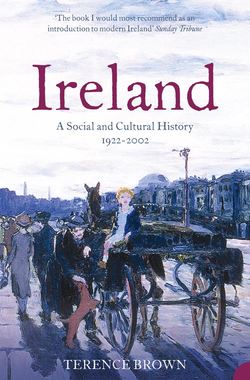Читать книгу Ireland: A Social and Cultural History 1922–2001 - Dr. Brown Terence - Страница 6
Preface
ОглавлениеThe main focus of this work is the intellectual and cultural history of Ireland since independence. It will quickly be evident, however, that I am also interested in establishing the main outlines of the social history of independent Ireland since the Treaty of 1921. I trust that my reasons for entertaining these dual ambitions will be clear from my text, but it may be as well to indicate them very briefly here.
It was necessary to establish an outline of modern Irish social history for this study since to fail to do so would be to suggest that high culture – intellectual endeavour and debate, the arts – has a life completely independent of the social reality in which it occurs of a kind which I do not believe it possesses. Ideologies, ideas, symbols, literary and cultural periodicals, even lyric poems are social facts, just as potato crops, tractors, and new industries are, and they can be fully understood only within the material world in which they come to life. So a recurrent preoccupation of this book in its first two parts is the analysis of how, for much of the period, certain ideas, images, and symbols provided Irish people with part of their sense of national identity. For this was a post-colonial society beset by manifold problems, but anxious nevertheless to achieve an independent and distinctive life. Part III of this book looks at how these conceptions and aspirations fared in the new social order that has been in the making in the last twenty years, following the economic revival of the early 1960s. But what also concerns me throughout is how social and cultural change are involved with one another. So the modernization of the last two decades in Ireland is seen to be in part the result of social and cultural factors that had been in the making since about the period of the Second World War, when the framework that had held together since independence began to disintegrate.
It is this concern to measure change and account for it that determines the structure of the book. Part I explores in detail the social and the cultural life of the Irish Free State in its first decade. Despite some signs of change, there was a conservative continuum with pre-revolutionary Ireland, and minorities and critics in the new order had little chance to make their will felt. Part II considers both how and why that continuity was sustained well into the modern period, but detects social and cultural evidences of major change in embryo and analyzes the possible causes of these. Part III presents the social and cultural history of the last two decades in the Republic of Ireland as a period of striking change when set against the picture that Parts I and II have painted of the earlier years of independence.
In Ireland intellectual, cultural, and social history are each infant disciplines. The writer who aspires to provide a study synthesizing the three areas is faced therefore with many insurmountable difficulties, not the least that much basic research has simply not yet been attempted. As a result, this book is very much a provisional and speculative sketch, with few pretensions to completeness in most areas. It is of course the danger of such sketches, particularly of recent and contemporary history, that they become mere caricatures. But without such attempts to chart the field, more fundamental research may not proceed as it must do if more assured works are to result in the future. It is as a preliminary mapping of the territory that I hope this book may prove useful.
I am grateful to the work of those scholars and critics who have, despite the perils, ventured into the turbulent scas of twentieth-century Irish historical research. My considerable indebtedness to them is clearly evident in my notes and references. Some of them are my colleagues in Trinity College, and I am happy to record here my gratitude to them too for their efforts to respond to my often naive inquiries in the last few years. I am also grateful to Miss Geraldine Mangan and Miss Dee Jones, who typed the manuscript at various stages of its production. To my wife, Suzanne, who arranged many things so that this work might be completed, my gratitude is expressed in the dedication.
T.B.
Trinity College, Dublin, 1977–80
